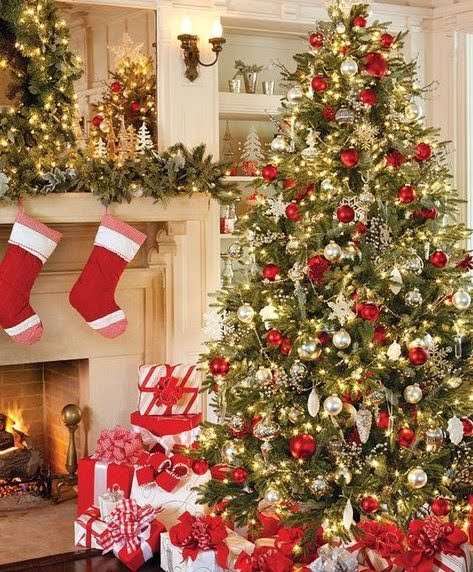Headline
10 Popular Christmas Traditions And Their Origins

Christmas is celebrated to mark the birth of Jesus Christ. Understanding the traditions associated with Christmas is important because, by knowing the origins and meanings behind these traditions, we can appreciate their depth and significance. This article explores the fascinating stories behind popular Christmas traditions.
Here are some of the popular Christmas traditions:
1. Red and green

When we think of Christmas, we often think of red and green decorations or red and green clothing. According to research, the association of the colours red and green with Christmas is traced back to a certain plant: holly. Holly plants are known for their bright green leaves and red berries.
Today, Christians have adopted the holly tree as a symbol for Christmas. The sharp leaves are said to symbolise the crown of thorns worn by Christ, while the berries represent his blood. Holly is a winter-blooming plant and may be one of the few signs of green during the season. Over time, the combination of red and green has become deeply ingrained in Christmas traditions, decorations, and imagery, representing the warmth and joy of the holiday.
2. Santa Claus

A main inspiration for Santa Claus is Saint Nicholas, a third-century Christian who was known for his kindness and charity. He also enjoyed giving kids gifts in secret. He later became a local folk hero, and stories about him expanded into elaborate myths and legends over the centuries. Over time, different customs and stories merged to create the modern image of Santa Claus that we know today.
With each new story, different cultures and peoples would add their unique twists and embellishments to the story of St. Nicholas.
READ ALSO: Peter Obi, Oladips, Others Make 2023 Google Most Searched Persons In Nigeria
As time went on, these characters barely resembled the original St. Nicholas and became totally new figures separate from him.
Today, many countries in the world tell stories of many different versions of a St. Nicholas-inspired character that gives gifts to children during Christmas.
3. Santa’s elves

According to legends, elves were small dwarf-like creatures with pointy ears who protected good people from evil. They stay at the North Pole with the legendary Christmas figure, Santa Claus, to help him in his workshop. These young magical creatures came in both genders and wore pointy hats and red and green clothes. They had long noses and sharp ears.
These elves worked in Santa’s workshop, assisting him in the creation of toys for good children all over the world. Apart from helping Santa in his workshop, the elves were also in charge of caring for Santa’s reindeer and carriage.
4. Santa’s reindeer

Since the release of Clement Clark Moore’s poem ‘A Visit from St. Nicholas’ in 1823, reindeer have been known as Santa’s sleigh pullers. From their habitat in the cold, icy Arctic, reindeer have evolved unique features that help them thrive in these harsh environments and make them the perfect Santa’s helpers. Their hooves have the ability to grow and shrink, depending on the season. Santa Claus’ reindeer are said to pull a sleigh through the night sky to help Santa Claus deliver gifts to children on Christmas Eve.
READ ALSO: Tinubu Threatened, Imposed Resolution On Fubara, Says Ex-Rivers Commissioner
5. Christmas stockings

This tradition can be traced back to the original Saint Nicholas, who was said to have put gold coins in the stockings of three poor sisters. One night, the girls left their stockings drying over the fireplace. Saint Nicholas knew the family was very poor, so he threw three bags of gold coins down the chimney. The money landed in the sisters’ stockings. Since then, children have been taught to hang up their Christmas stockings on Christmas Eve, hoping to find them filled with gifts in the morning. This comes with the anticipation and excitement of receiving presents.
6. Christmas trees

The Christmas tree is a cherished tradition. People bring a beautiful evergreen tree into their homes and decorate it with lights, ornaments, and garlands. Families often gather around the tree to exchange gifts. Decorating buildings with trees during the winter is a practice that can be traced back to ancient peoples like the Romans and Egyptians, who often used trees to add to the beauty of shrines or temples.
However, the modern Christmas tree is said to come from German medieval traditions. Germans would decorate a tree in their homes on December 24 in order to celebrate the feast day of Adam and Eve. As time went on, these trees would also be used to celebrate the birth of Jesus Christ during Christmas. Whether real or fake, a beautifully decorated Christmas tree can often be found inside a heavily decorated home, just waiting for St. Nick to put wonderful presents (or a pair of socks) underneath it.
7. Presents

St. Nicholas was known to give gifts to children, which is why his ‘descendant’, Santa Claus, does so as well. Gift-giving also has its roots in pagan rituals held during the winter. When Christianity folded these rituals into Christmas, the justification for bearing gifts was redirected to the Three Wise Men, the Magi, who gave gifts to the infant Jesus. As for modern Christmas gift-giving, this tradition seems to have been strengthened and encouraged thanks to the popularity of Santa Claus and the commercialization of Christmas.
READ ALSO: Delta Police Foil Robbery Attempt, Recover Weapons
8. Christmas Carol

Carols have their roots in pagan rituals appropriated by the nascent Christian Church when, in the 4th century, it officially named Christmas the celebration of Christ Jesus’ birth. Carols were first sung in Europe thousands of years ago, but these were not Christmas carols. They were pre-Christian or pagan songs sung at the Winter Solstice celebrations. The Winter Solstice is the shortest day of the year, usually taking place around December 22. Christmas, remembering the birth of Jesus, then started to be celebrated at the same time as the solstice, so the early Christians started singing Christian songs instead of pre-Christian or pagan ones.
9. Christmas bells

You cannot talk about the sounds of Christmas without mentioning Christmas bells. Bells have always been rung for a variety of reasons. The ringing of bells has been an important part of celebrating Christmas since ancient times. Bells have been used in the past to not only provide music and a sense of celebration, but they have also been rung to announce the arrival of the Christmas season. They can symbolize the announcement of the birth of Christ. Bells were also part of the Jewish high priest’s garments. Christmas bells not only symbolize the joy of Christmas; they also remind us that Christ is the High Priest.
Christmas bells can be seen on light posts that light up the streets at night, are hung on many Christmas trees, and can be heard in every house in America that celebrates Christmas.
10. Boxing Day

Boxing Day is a holiday celebrated after Christmas Day, occurring on December 26. Boxing Day got its name when Queen Victoria was on the throne. In Victorian times, the wealthy would box up items they no longer needed to give to the poor. It was a day where servants would be given time off and thanked for their hard work with a ‘special box’ of treats.
Other reports say that many people believe that the tradition of Boxing Day began in churches in the Middle Ages, where parishioners would collect money for the poor. This was done to honour St. Stephen, the first Christian martyr, whose feast day fell on December 26
PUNCH
Headline
British Family Accused Of Boarding Dead Grandmother On EasyJet Flight

A British family has been accused of trying to board a dead relative onto an EasyJet flight from Málaga, Spain, to London Gatwick on Thursday, passengers said.
The woman, reportedly 89 years old, was wheeled onto the plane by five family members, who told airline staff she was unwell and had fallen asleep.
Witnesses said the woman was pushed in a wheelchair to the rear of the plane and lifted into her seat. Some claimed they overheard a family member tell a boarding clerk, “It’s OK, she’s just tired,” adding, “It’s OK, we’re doctors.”
READ ALSO:Gunmen Invade Church, Kill Priest’s Wife In Anambra
Just before takeoff, the cabin crew realized the woman had died, and the plane was turned around, delaying the flight by 12 hours.
Petra Boddington, a passenger, said: “easyJet, when did you start letting dead people onto planes? Seriously!” Another, Tracy-Ann Kitching, added: “I saw her being wheeled onto the plane; someone was holding her head as they passed me! A doctor on board confirmed that was already dead when they sat her down.”
EasyJet has denied that a deceased person boarded the plane. The airline said the passenger had a fit-to-fly certificate and was alive when she boarded.
READ ALSO:UK Charges Nigerian-British Art Dealer Ochuko Ojiri With Terrorism-related Offence
“The flight returned to the stand prior to take-off due to a customer on board requiring urgent medical assistance. The flight was met by emergency services, but sadly the customer passed away,” a spokesperson said.
The Guardia Civil in Málaga confirmed officers attended the aircraft, and the woman was declared dead on board. No arrests have been made.
Headline
Russian Strike On Odesa Region Kills Eight, Injures 27

Ukraine’s State Emergency Service has reported at least eight people killed and 27 others injured on Friday night after a Russian ballistic missile strike hit the southern Ukrainian city of Odesa.
According to Ukrainian authorities, the attack targeted port infrastructure facilities in the town of Pivdenne, near Odesa, and damaged nearby civilian vehicles.
The strike came one week after much of Odesa was left without power, heat, and water following a “severe” aerial assault.
“Some of the injured were on a bus that was at the epicenter of the shelling. Trucks caught fire in the parking lot, and cars were also damaged,” the State Emergency Service said.
READ ALSO:Russia Insists Ukraine Must Cede Land Or Face Continued Military Push
Emergency officials said the deaths occurred at a port infrastructure facility. Medical teams and first responders were deployed after the strike, but their work was disrupted by “ongoing air raid alerts,” according to Oleh Kiper, head of Odesa’s regional administration.
Russia has carried out repeated attacks on Odesa in recent days, damaging port facilities, civilian vessels, and key infrastructure.
Two major bridges linking the northern and southern parts of the Odesa region have also been hit, with repairs under way, Kiper said.
Elsewhere, Ukraine’s State Emergency Service reported a “massive” drone attack on the southern Mykolayiv region, which damaged civilian infrastructure and vehicles. No casualties were reported.
READ ALSO:19 Die From Alcohol Poisoning In Russia
Odesa, Ukraine’s largest seaport and a major hub in the Black Sea region, has been a frequent target since the start of the war.
Last week, civilian, energy, and industrial sites in the city suffered extensive damage after what regional officials described as “one of the enemy’s most severe airstrikes,” leaving many areas without power and water.
Russia’s Defence Ministry has not commented on the attack.
Speaking hours before the strike during his annual Direct Line call-in show, Russian President Vladimir Putin said Russia was yet to “see Ukraine’s readiness for peace”.
“[Russia] is ready for negotiations and for ending the conflict via peaceful means,” Putin said, adding that it was up to Russia’s “Western opponents” to end the war.
(CNN)
Headline
Aircraft Crashes In Owerri With Four Persons Onboard

A Cessna 172 aircraft with registration number 5N-ASR, operated by Skypower Express, has crashed at the Sam Mbakwe International Cargo Airport, Owerri, Imo State.
The aircraft had departed Kaduna International Airport en route to Port Harcourt International Airport before diverting to Owerri after the crew declared an emergency.
The crash occurred at about 8:00 pm on the airport premises, with four passengers and crew members onboard.
Confirming the incident, the Director, Public Affairs and Family Assistance of the Nigerian Safety Investigation Bureau (NSIB), Mrs. Bimbo Oladeji, said the agency had been notified of the crash.
READ ALSO:Social Media Feud Spills Into Aircraft As VDM, Mr Jollof Exchange Blows
According to the NSIB, the aircraft crashed on the approach area of Runway 17, but no fatalities have been recorded so far.
The statement said: “Following the occurrence, airport emergency services were successfully activated and arrived on site promptly. Reports indicate that there was no post-crash fire, and the runway remains active for flight operations, with other aircraft taking off safely after the incident.
“Efforts are currently underway to coordinate the recovery and evacuation of the distressed aircraft from the crash site to allow for a detailed wreckage examination.”
The NSIB said it has officially activated its investigation protocols in line with its statutory mandate
READ ALSO:Ogun To Prosecute DJ Over Multiple Road Crashes
The Director-General of NSIB, Capt. Alex Badeh Jr., sympathised with the management of Skypower Express over the incident and expressed relief that no lives were lost.
Badeh Jr. added that the Bureau’s investigation team is already coordinating with relevant authorities to secure the crash site and commence a detailed investigation into the cause of the accident.
Two days ago, 11 persons narrowly escaped death as a private jet crash-landed at Mallam Aminu Kano International Airport, Kano, on Sunday morning.
The occupants, including passengers and cabin crew, were safely evacuated amid an intense atmosphere, eyewitnesses told The Guardian.
READ ALSO:Tanker Crash Kills Three, Fire Razes Shops In Kano
The private jet, owned by Flybird Aviation, crash-landed at about 9:30 a.m. while approaching Kano Airport en route to Abuja.
The incident attracted urgent attention, with emergency staff and other stakeholders converging at the runway to render rescue operations.
The management of the Federal Airports Authority of Nigeria (FAAN) is yet to release an official statement on the incident. Unofficial sources disclosed that the passengers have been taken to an unknown destination.
Several aircraft incidents have occurred at Kano Airport, with several lives lost.
The last incident occurred in May 2002, when an EAS Airline aircraft departed the runway at Aminu Kano International Airport at 1:29 p.m. local time en route to Lagos.

 Metro5 days ago
Metro5 days agoAlleged Organ Harvesting: Bereaved Families Rush To Check Corpses

 News4 days ago
News4 days agoPolice Confirm Edo Tanker Explosion, say No Casualty

 News3 days ago
News3 days agoFormer Delta North senator Peter Nwaoboshi Dies

 Metro2 days ago
Metro2 days agoJUST IN: Former Edo Information Commissioner Is Dead

 News4 days ago
News4 days agoGrassroots To Global Podium: Edo Sports Commission Marks Enabulele’s First Year In Office

 News5 days ago
News5 days agoEdo SSG Calls On Media To Support Govt Policies, Assures Better Welfare

 News4 days ago
News4 days agoOkpebholo Sympathises With Otaru, People of Auchi Over Tragic Tanker Fire Incident

 News4 days ago
News4 days agoOtuaro Tasks Media On Objective Reportage

 News4 days ago
News4 days agoIPF Hosts Media Conference, Seeks Protection For N’Delta Environment

 News3 days ago
News3 days agoCoordinator, Edo First Lady Office, Majority Leader, Rights Lawyer, Others Bag 2025 Leadership Award
































